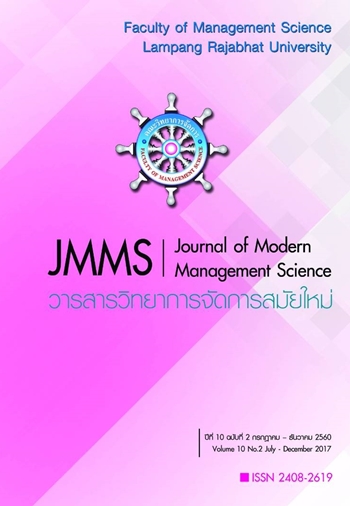The Influence of Modern Accounting System on Organization Management Efficiency : Case Study of SMEs in Thailand
Main Article Content
Abstract
The purpose of this study is to examine the influence of modern accounting system on organization management efficiency. Modern accounting system is consisted of faster accounting processing, increasing functionality, better external reporting, and real-time reporting. This research used the resource-based view of the firm to be a basic concept in research. The modern accounting system is one of the important firm resources that can help firm transform a shot-run competitive advantage into a sustained competitive advantage by improving organization management efficiency. The data are collected from 400 SMEs in Thailand via mail. The completed questionnaires of 118 are sent back. The results of OLS regression reveal that all dimensions of modern accounting have positive effects on organization management efficiency.
Article Details
The article must be considered and accepted for publication by the editorial board of the Faculty of Management Science, Lampang Rajabhat University. The articles have been reviewed by a peer (peer review) and the author must update according to the suggestion if available before publication. Articles that are not considered the editorial team will inform the results of the consideration but will not send the original to the author.
JMMS is the Faculty of Management Science journal, Lampang Rajabhat University. Jmms published both print and online editions. We allow the use of articles for academic use under the scope of copyright law.
References
สำนักงานส่งเสริมวิสาหกิจขนาดกลางและขนาดย่อม. (2556). รายงานสถานการณ์ SMEs ปี 2554-2555. สืบค้นเมื่อ 18 มีนาคม 2559 จาก http://www.sme.go.th/Pages/whitePaper/art_17.aspx, 2013
Aaker, D. A., Kumar, V. & Day, G. S. (2001). Marketing Research, New York: John Wiley and Sons.
Armstrong, J. Scott & Overton, Terry S. (1997). Estimating Non-response Bias in Mail Surveys, Journal of Marketing Research, 14(3).
Barney, Jay. (1991). Firm Resources & Sustained Competitive Advantage, Journal of Management, 17(1).
Boonmunewai, Somjai & Ussahawanitchakit, Phapruke. (2010) Internal Audit Competency, Organizational Outcomes and Firm Success: An Empirical Evidence from Thai-Listed Firms, Journal of International Management Studies, 10(4): 1-24.
Braun, Robert, L. & Davis, Harold, E., (2003) Computer-assisted audit tools and techniques: analysis and perspectives, Managerial Auditing Journal, 18 (9), 725.
Capron, L. & Hulland, J. S. (1999). Redeployment of brands, sales forces, and marketing expertise following horizontal acquisitions: A resource-based view. Journal of Marketing, 63.
Chou, C. L., Du, T., & Lai, V. S., (2007) Continuous auditing with a multi-agent system Decision Support Systems, 2274-2292
Day, George S. (1994) The Capabilities of Market-Driven Organizations, Journal of Marketing, 58.
Ghasemi, M., Shafeiepour, V., Aslani, M. & Barvayeh, E. (2011). The impact of Information Technology (IT) on modern accounting systems, Social & Behavioral Sciences, 28,
112-116
Grant, R. M. (1991). The Resource-Based Theory of Competitive Advantage: Implications for Strategy Formulation, California Management Review, 33(3).
Guney, A., (2014) Role of technology in accounting and e-accounting Procedia - Social and Behavioral Sciences 152 (2014) 852 – 855
Maijoor, S. & Wittleloostuijn, A. Van. (1996). An empirical test of the resource-based theory : Strategic regulation in the Dutch audit industry, Strategic Management Journal, 17.
Makadok, Richard. (2001). Toward a Synthesis of the Resource-Based View and Dynamic-Capability Views of Rent Creation, Strategic Management Journal, 22 (5).
Mia, L. M. & Patiar, A. (2001). The use of management accounting systems in hotels: an exploratory study, Hospitality Management, 20.
Neter, J, William W. & Michael H. K. (1985). Applied Linear Statistical Models: Regression, Analysis of Variance, and Experimental Designs, 2nd Edition, Homewood: Richard D. Irwin, Inc.,
Nunnally, J. C. & Bernstein, I. H. (1994). Psychometric Theory, New York, NY: McGraw-Hill.
Penrose, E. T. (1959). The Theory of the Growth of the Firm. New York: Wiley.
Sumritsakun C. (2013). Antecedent and consequence of CAATs Implement Success in Internal Audit: Case Study of Thai-Listed Companies, Review of Business Research, 13(2).
Sumritsakun, C. & Ussahawanitchakit, P. (2009). Internal Audit Innovation and Firm Stability of Thai Listed Company: How Do Implement in an Organization, Journal of Academy of business and Economics, 9 (4).
Sumritsakun, Chaiyot. (2012). The Effect of Accounting Information System Effectiveness on Accounting Information Usefulness via Information Trust and Information Timeliness as Mediators: Case Study of Thai-Listed Companies, International Journal of Business Research, 12 (1).
Tiessen, P., & Waterhouse, J. H. (1983). Towards a descriptive theory of management accounting, Accounting, Organizations and Society, 8.
Warren, J. D. & Smith, L. (2006). Continuous Auditing: An Effective Tool for Internal Auditors, SSRN.
Williams, J. J. & Seaman, A. E. (2002). Management accounting systems change and departmental performance; the influence of managerial information and task uncertainty, Management Accounting Research, 13.


